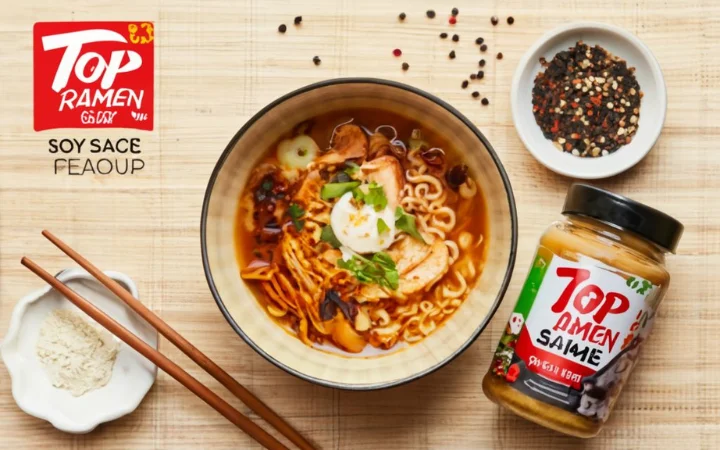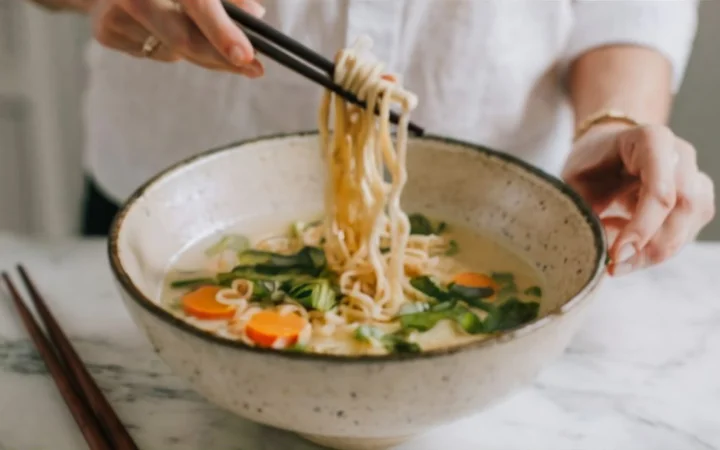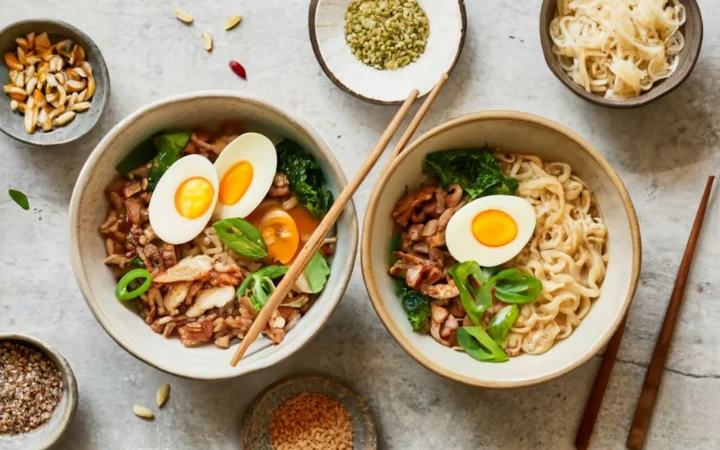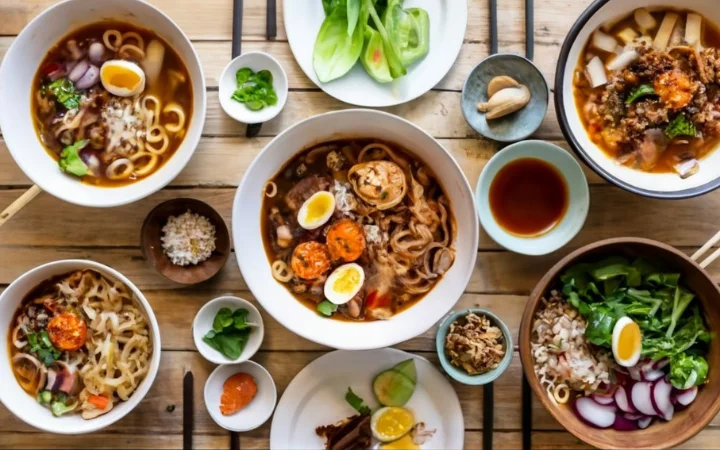In this comprehensive guide, we’ll dive deep into the world of gluten free ramen, exploring its types, cooking methods, health benefits, and much more. Whether you’re a celiac patient, gluten intolerant, or simply curious about this healthier alternative to traditional ramen, this article has got you covered. So, let’s embark on this delicious journey and discover everything there is to know about gluten free ramen.
Introduction to Gluten Free Ramen
What is Gluten Free Ramen?
This wheat-free noodle option is more than just a trend; it’s a lifesaver for many! Made without wheat or any gluten-containing ingredients, these noodles cater to those with celiac disease, gluten intolerance, or anyone looking to reduce their gluten intake. Unlike traditional ramen, which is typically made from wheat flour, gluten free ramen is crafted from alternative grains like brown rice, millet, or even ingredients like Japanese rice flour. The result? A bowl of ramen that’s just as slurp-worthy but without the gluten!
The Rise of Gluten Free Diets
In recent years, gluten free diets have skyrocketed in popularity. This isn’t just a fad; for many, it’s a necessary lifestyle change. People with celiac disease, wheat allergies, or gluten sensitivity have found refuge in gluten free options. But it’s not just them; even those without specific health concerns are hopping on the gluten free bandwagon, seeking out healthier, more digestible food options. And that’s where these wheat-free noodles come into play, offering a delicious and comforting meal that aligns with these dietary needs.
Stay tuned for next Part, where we’ll explore the different types of gluten free ramen available in the market, including popular brands like Lotus Foods and King Soba. We’ll delve into the unique flavors and textures that make each type stand out, ensuring you find the perfect bowl of ramen to satisfy your cravings!
Exploring Different Types of Gluten Free Ramen
Lotus Foods Ramen Noodles
Lotus Foods shines in this niche with their innovative approach to noodles. They utilize grains like millet and brown rice, which not only impart a unique nutty flavor but also offer a delightful texture that’s similar to traditional ramen. These noodles cook in a matter of minutes, making them an ideal choice for those seeking a quick, nutritious meal. The high fiber content and essential nutrients in these grains contribute to a healthier diet, while their gluten free nature makes them suitable for a wide range of dietary needs.
King Soba Noodles
King Soba provides a diverse range of wheat-free noodle options, catering to various taste preferences. Their noodles are made from ingredients like buckwheat, quinoa, and sweet potato, each bringing a distinct flavor profile to the table. These noodles are not only gluten-free but also organic, appealing to health-conscious consumers who prioritize clean eating. King Soba’s ramen is perfect for culinary adventurers who enjoy exploring different flavors and textures in their cooking. The brand’s commitment to quality and variety ensures that there’s something for everyone in their product line.
Nissin Foods Top Ramen Soy Sauce Flavor
Nissin Foods introduces a wheat-free version of their beloved Top Ramen with the Soy Sauce Flavor. This product marries the classic, savory taste of soy sauce with the benefits of gluten-free noodles, making it an excellent choice for those who crave the traditional ramen experience without the gluten. Nissin’s dedication to maintaining the authentic flavor while accommodating dietary restrictions has resulted in a product that satisfies both taste and health needs. The Top Ramen Soy Sauce Flavor is a testament to the brand’s ability to innovate and adapt to changing consumer preferences.

In the next Part , we’ll delve into the art of cooking gluten free ramen, offering basic techniques and creative recipes to elevate your ramen experience. Whether you’re a seasoned chef or a cooking novice, these tips will help you create a delicious bowl of gluten free ramen in no time.
Cooking and Preparation
Basic Cooking Techniques
Firstly, cooking gluten free ramen is surprisingly simple. Start by boiling water in a pot, then gently add the noodles. Secondly, stir occasionally to prevent sticking. Thirdly, cook the noodles for the recommended time on the package, usually just a few minutes. Finally, drain the noodles and rinse them under cold water to stop the cooking process. Now, you’ve got perfectly cooked wheat-free noodles, ready for your favorite broth and toppings!
Creative Gluten Free Ramen Recipes
Moreover, the beauty of these wheat-free noodles lies in their versatility. For instance, you can create a classic miso ramen by adding a savory miso-based broth to your noodles. Alternatively, spice things up with a fiery kimchi ramen, perfect for those who love a bit of heat. Additionally, for a refreshing twist, try a cold ramen salad with fresh vegetables and a tangy dressing. The possibilities are endless, allowing you to explore a world of flavors while sticking to a gluten-free diet.

In the next Part, we’ll delve into the health benefits and considerations of gluten free ramen. Not only is it a delicious alternative to traditional ramen, but it also offers various nutritional advantages. Stay tuned to learn more about how gluten free ramen can be a beneficial addition to your diet!
Health Benefits and Considerations
Nutritional Value of Gluten Free Ramen
These wheat-free noodles offer several nutritional advantages, making them a beneficial choice for various diets. Many gluten free ramen varieties are made from whole grains like brown rice and millet, which are rich in fiber, vitamins, and minerals. This high fiber content aids in digestion and contributes to a feeling of fullness, which can be helpful for weight management. Additionally, these whole grains provide essential nutrients that are often lacking in traditional wheat-based noodles.
Furthermore, these alternatives are typically lower in calories and fat compared to their wheat-based counterparts. This makes it an appealing option for those looking to maintain a balanced diet without sacrificing flavor. However, it’s important to be mindful of the overall nutritional content, as some gluten free ramen products may contain added sugars or high levels of sodium.
Who Should Eat Gluten Free Ramen?
This noodle alternative is an excellent choice for individuals with celiac disease, gluten sensitivity, or wheat allergies, as it allows them to enjoy a beloved dish without adverse health effects. It’s also a great option for those looking to reduce their gluten intake for personal health reasons, such as improving digestion or reducing inflammation.
However, it’s crucial to remember that a wheat-free label does not automatically equate to a healthier product. Consumers should always read labels carefully to understand the nutritional content of the product. For individuals without specific gluten-related health concerns, gluten free ramen can still be a part of a balanced diet, especially when opting for varieties made from whole grains.

In the next Part , we’ll guide you through the process of buying the best gluten free ramen, covering both online and in-store options. Stay tuned to discover where to find a wide range of gluten free ramen that suits your taste and dietary preferences.
Where to Buy the Best Gluten Free Ramen
Online Retailers and Specialty Stores
Online retailers are a great source for these wheat-free noodle varieties. Websites like Amazon offer a wide range of brands and flavors. You can easily find your favorite type or try something new. Specialty health food stores are also a good option. They often stock a variety of gluten-free options. These stores are great for those who like to read labels and inspect products closely.
Local Grocery Stores and Supermarkets
Local grocery stores and supermarkets are increasingly offering these wheat-free options on their shelves. Brands like Lotus Foods and King Soba are becoming more common. Look in the ‘health food’ or ‘gluten-free’ sections of these stores. The availability of specific brands and flavors might vary. It might take some searching to find your favorites.
In the next Part , we’ll answer some frequently asked questions about gluten free ramen. We’ll cover common queries and provide useful insights. This will help you make informed choices about gluten-free ramen. Stay tuned for helpful tips and answers to your questions!
Frequently Asked Questions About Gluten Free Ramen
Common Questions and Answers
- Is it healthier than regular ramen?
- These noodle alternatives can be healthier, especially for those with gluten sensitivities It often has more fiber and nutrients. But, check for added sugars and sodium.
- Can I make it taste like traditional ramen?
- Yes, you can! Use the right broth, seasonings, and toppings. Try soy sauce, miso, and fresh herbs for great flavor.
- Are there vegan options?
- Many gluten free ramen brands offer vegan options. Look for noodles without animal-derived ingredients like egg or dairy.
- How long does it take to cook ?
- Cooking times vary by brand. Most specialty noodles cook in a few minutes. Always follow the package instructions.
- Can I find it in regular grocery stores?
- Indeed, many grocery outlets now stock a variety of these special dietary noodles. Look in the health food or gluten-free sections. Availability may vary.
In the next Part, we’ll wrap up our guide on gluten free ramen. We’ll summarize key points and provide final thoughts. Gluten free ramen is a fantastic option for various dietary needs. Stay tuned for our conclusion and final insights!
Conclusion
In conclusion, this noodle alternative is a fantastic alternative for those with celiac disease, gluten intolerance, or anyone looking to reduce their In recent years, gluten free diets have skyrocketed in popularitygluten intake. With brands like Lotus Foods and King Soba, there’s a wide range of flavors and textures to explore. Whether you’re cooking a quick meal or experimenting with creative recipes, it offers versatility and convenience.
Furthermore, the health benefits of this dish, particularly those made from whole grains, make it a nutritious option. However, it’s important to be mindful of added sugars and sodium in some products. it’s readily available online, in specialty stores, and increasingly in local grocery stores, making it accessible to a wide audience.

In summary, gluten free ramen is more than just a dietary alternative; it’s a delicious and healthy option that caters to diverse tastes and needs. Whether you’re a seasoned ramen enthusiast or new to the world of gluten free options, there’s never been a better time to explore the delicious possibilities of it.
